Michelle L. Rusk's Blog, page 44
September 28, 2015
The Call to BE Loved
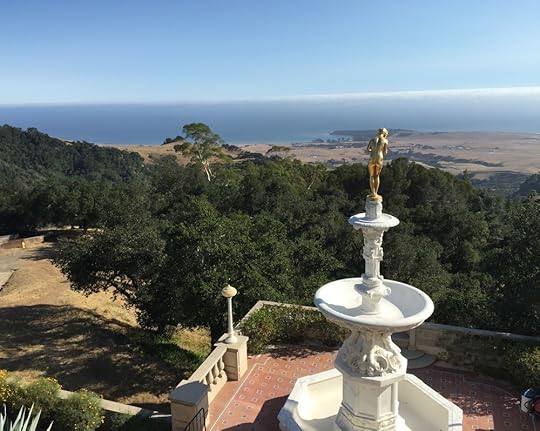
Last week I wrote about the importance of love and how we are called to love. However, we often forget that part of that call is learning to be loved.
A friend who attended all the events of my wedding was talking to someone after it was over, telling her about all the emotions she felt and all the love that swirled in the air, when the friend asked, "You have a hard time accepting love, don't you?"
For some of us, it's easier to love than it is to be loved. It's like giving out compliments is easier than receiving them, or how giving material gifts is easier than receiving them. We feel strange and awkward to accept them.
But if we are to love, we also need to remember that we are called to be loved, too. Love is reciprocal (although many times those we are called to love don't seem to love us). It doesn't matter though, we should accept the love that's given to us. And the more we accept the love someone is handing to us, the more love we will feel. And that gives us more love to give to others.
September 24, 2015
The Call to Love
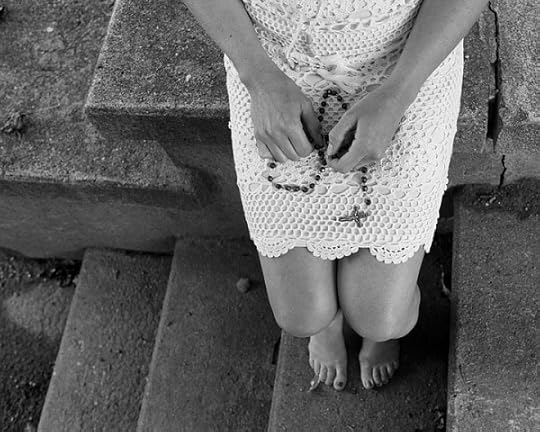
It's hard not to be inspired by the Pope's visit to the United States. For me, it's a far cry from the annoyance I felt when Pope John Paul II arrived in 1979 and I was upset that "Laverne & Shirley" was interrupted (and I couldn't understand my mom's excitement as he walked off the plane at O'Hare). Over the last two days though, it's not just seeing the Pope that's exciting, it's also seeing the excitement of people who are excited to see him.
Pope Francis has been a breath of fresh air because he's reminding us of what matters most in life but gets lots in, well everything: the call to love.
Love is the most basic tenet of life, it is what we all strive to do, to be be. However, in the course of everything around us (and a lot of how others treat us), we fall short of it easily. In the last few minutes my dog Gidget was barking crazily at the postal delivery man, then the FedEx driver, then the postal worker again (he came back with a package). This is the perfect example– it was hard to remember to love as Gidget is barking and running around the house, also stirring the other three to bark.
Somewhere in ourselves, Pope Francis is asking us to take a step back and remember what's most important. I get the challenge of this: after the Pope spoke to Congress this morning, I got in my car to run a few errands and found myself annoyed with a woman on my street who decide to stop her car in the middle of the street. I hadn't even left my street and I was already annoyed! Those are the moments where we should take that step back.
Yes, it was annoying but I have no idea what was going on in those tinted windows. And being annoyed with her was wasting my own energy. For all I know, one of her kids was causing a ruckus, and she was trying to calm them down before she entered her driveway.
Whatever it is, whatever happens, the only thing important is love. When our lives come to an end we want to know that we loved as much as possible. Because, once again, there are no regrets, if we focus on the here and now, covered with love.
September 23, 2015
Accepting the Path

Before we can take our lives forward, we must accept what's happened to us in the past. While I don't believe in dwelling in the past– because you end up missing the great things happening around you in the present when you're stuck in your pain– we must acknowledge where we've been, even though it hurts and it's embarrassing.
I could make a list of events that have happened in my life that haven't been pleasant, that have involved painful losses, that have constantly forced me to keep myself moving forward even when I didn't want to. There are a number have events that I'm embarrassed about, particularly because I thought certain people were more truthful than they were. But the reality is that they happened. I work on shaking them off and move on.
I can't change them. I can't go backward. But what I can do is– despite the pain– look back and focus on what I learned from them. While we aren't happy about the way that past relationships might have ended, the good part is that I'm sure we learned something. And if you don't think you learned something then you have some work to do. Life is about learning. After all, if there were nothing to learn, we probably wouldn't be here.
However, once we accept they happened and we take an inventory of what we learned, what we are grateful for (an unhealthy relationship being over is something to be glad about), it is then that we can go forward because then the chances are good we won't repeat the past mistakes.
September 21, 2015
Flowers by Day, Stars by Night: Finding Happiness after Loss and Change
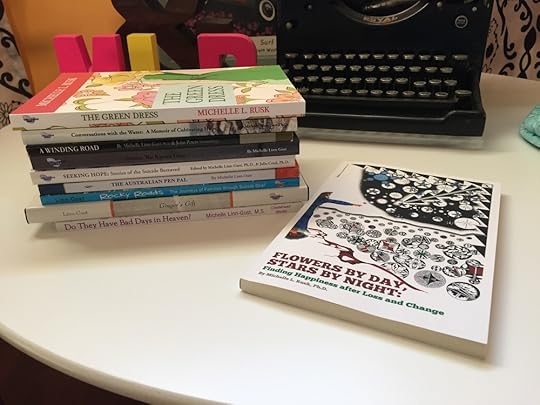
For years I have spoken about what happens after you lose someone to suicide. I have explained everything from the emotions to the guilt to the whys. And I've talked somewhat about how you cope with it, but mostly people hung onto trying to understand why they felt the way they do (because we don't do a good job of explaining the grief process to people).
Then one day, someone asked, "But how have you done it? How have you continued with your life? How have you been able to smile and laugh again?"
That's when I began to take a look back on all that I have learned about coping with loss (much of which I absorbed before my sister died although I had no idea what I was teaching myself). And as the losses continued to happen: my dad, my marriage, my mom, as well as the changes that happen in life (moving, new job situations, etc.), it became more clear how I have been able to continue forward with my life, and find hope.
This book isn't just one where you read about my experience. While that's part of it– after all my experiences are what I pulled from and give me the stories to tell– this book also gives you steps to take your life forward to finding happiness and hope in your life. There are journal entries and other activities to do, too.
What I set out to create with this book was something for any type of loss or change that someone might be faced with. As a friend who read it said, if you're human, then you can relate to this book. I want Flowers by Day, Stars by Night to be the book that people reach for when they see life can be better, that they don't have to be stuck that mud puddle. My hope is that people will take the time to follow the steps and use them as I have to help me.
And most of all, I hope it inspires people to make change. After all, we all have that chance.
September 17, 2015
Accepting Reality

While I have known that Chaco is slowing down– he is almost fifteen– I got smacked with reality over Labor Day weekend.
That Sunday we were having a pool party and about 90 minutes before it started, I was busy in the kitchen preparing prickly pear punch and lemonade. I typically give the dogs a treat around 10 am (although Nestle believes that all hours of the day are 10 am) and he is usually sleeping in a bedroom so I put the treat aside and when he wakes up and comes out to see the rest of us, I give it to him then. That's exactly what I did that morning.
The problem was that Chaco couldn't take the treat. It was almost as if the rug he stood on were a boat and he couldn't steady himself. He couldn't get the treat to his mouth and he was having trouble using his back legs.
This went on for several minutes until he finally regained his legs and was able to take a treat (not that giving him one was the smartest thing to do on my part). He returned to the bedroom where he likes to sleep and I tried to turn my attention back to the party.
It wasn't easy. I kept thinking; while 30 people are at my house, was Chaco going to die? Would I find him dead later in the bedroom? I interrupted my preparations and walked down the hall where I sat on the floor with him, running my hands across his fur and talking to him. By then we had figured he'd had a mini stroke. One of my mom's dogs had a stroke and died within the hour. Mom knew what was happening and sat with Daisy as her life came to an end.
If Chaco had the chance to list things he hates in the world (which would include anything on wheels and being given pills), he would also add when I cry. He leaves the room as soon as I start. Not so this time. However, I finally got the courage up– simply because I wasn't ready to let him go– to tell him if he needed to go, it was okay, that I knew Mom and everyone else would greet him.
As soon as I said it? Chaco got up and left the room.
It was as if he were saying, "Not my time to go. Get over it."
The party went on, he's been fine since– although he's slowed down so much this past year. And for me, I try to enjoy each day with him and spend time with him. While it's always possible one of the younger dogs could died before him (Nestle is next in line at 12 and then Hattie at 10), I also realize it's more than likely he'll be next.
It doesn't mean I'm ready and I doubt I ever will be. More than anything, I want to allow him to age gracefully and died just as gracefully. At 14 he's had a great life and anything else will be frosting on the cake.
September 14, 2015
The Woven Friendship
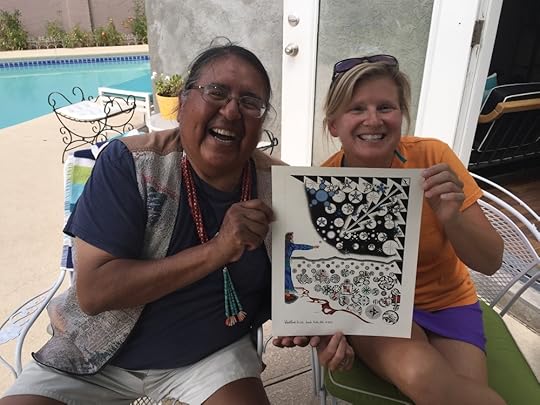
Gary Keene and I have been trying to work on a project together for a long time. Gary was a friend of my former husband's. We didn't see him often, mostly because our lives were going in different directions. In 2003, Gary led the service for the suicide bereaved at the American Association of Suicidology conference in Santa Fe that year. We all stood on the roof of the LaFonda hotel, receiving a blessing from Gary.
While his art hung all over our house, in the last years of our marriage, I didn't see much of him. But when someone came to visit from out of town, we have several places we like to take them and Acoma Pueblo is one of them. Gary's home.
Acoma sits west of Albuquerque, the original settlement on top of a mesa, called Sky City. For me, it's one of the most sacred places in New Mexico.
We had seen Gary at some point and he said he was a tour guide "up top" as they say. And each time I took someone to Acoma, Gary usually ended up serving as our guide.
But after my hiatus from New Mexico, I knew he wasn't working there anymore, instead devoting all his time to his art. It was only through the prodding of a friend who planned to attend my wedding and wanted to talk to a Native American about language for research he was doing that I found myself getting in contact with Gary. The number I had didn't work, but I knew if I sent him a card in the mail (what a novel concept!) he would get it and call me.
While the friend didn't come to the wedding, he brought Gary and I back together. During that time, I was at least pretending to work on Flowers by Day, Stars by Night: Finding Happiness after Loss and Change, and after Gary agreed to doing a blessing at our wedding reception, I asked him to design the book cover.
Finally, the project we had talked about for so long came together.
As Gary put his pens to paper and created the intricate details you see on the cover (only visible when you see it up close), I felt his energy of wanting to help others heal and find hope and happiness again. It was as if the timing was finally right for both of us to give something together to others.
Be Present

We all do it: we are either too busy looking back on the past of our lives, or too caught up in hoping what's ahead, that we forget to keep ourselves rooted in the present. The problem with not being present is that we miss what's right in front of us. And sometimes it's missing out in time with someone we care about.
I will be the first to admit I'm guilty of it. I have to consciously remind myself to be present, not be thinking about tomorrow, or something that might have already happened that I don't understand. It's like retraining my brain.
While none of us know how long our lives will last– or those of our loved ones– we still take life for granted. We believe that when something bad happens, it won't happen to us, that it happens to the family down the street. And so we continue through our lives, taking everyone for granted. We look back, we look forward, but we aren't in the now.
And then when something happens, such as someone we care about dies, we realize what we missed. Sometimes we have multiple deaths and we still find ourselves taking the present for granted.
The reality is that life is short and none of us are promised anything. Last week I was talking to someone who has a daughter who has attempted suicide before and isn't doing so well. It's hard to know what to say– you hope the daughter will find hope, but for some people there are so many factors that keep them from ever reaching the glass half full status. Mental illness tumbles through the brain and wreaks havoc with their thinking.
All I could think to tell him was to be present, something I know he knows, to enjoy every minute with her, because then there will be no regrets.
We all wish we could turn back the clock because I'm sure we all have a least one person, if not several, that we'd like to spend more time with, to have another conversation with, but it didn't work out that way.
Instead, we need to take that lesson with us into our lives today and be present with everyone who crosses out path. And then we won't have any regrets no matter what happens.
September 10, 2015
World Suicide Prevention Day

Every year I find myself writing about purple and turquoise for World Suicide Prevention Day.
For many years, much of my life was caught up in this day, week, and month, surrounding events about educating people about suicide. I had tried diligently (and passionately) to create a day for the suicide bereaved– and had quite a bit of support– but ended up giving up the fight as I realized it was time for me to move on to pursue other interests in my life.
Sandy Martin, who died about ten years ago, and I started the movement to use purple and turquoise as colors to represent suicide. We went with two colors because it seems as if every cause had already taken one. Here in the Southwest turquoise is important for the Native Americans, known as a healing color.
Initially, it was about the suicide bereaved but as I handed out the first ribbons we made (before the ribbon pins were created) at an American Association of Suicidology Conference, one woman said, "I doubt there is anyone in this room who hasn't been affected in some way by suicide."
After that, when anyone asked me what the colors were for, I said it was for anyone who supported the cause: whether someone was bereaved, knew someone who attempted, was an attempt survivor, worked with the suicidal, or just wanted to support the cause.
In moving on, that also meant I passed it along to other people to continue to use the colors. One year I saw on Twitter someone had decorated a Christmas tree using purple and turquoise decorations.
And for me, I feel as if I'm standing across the street, having laid the foundation with Sandy, but now I'm watching as other people continue to build the building. It's not easy sometimes as it was such a part of my life for so long. However, I know that I can't put off some dreams of mine any longer. More than ever, I have a sense that it's time for me to do the things I've always to do and trust that others will take this movement forward while I stand and watch.
And nod my head approvingly.
September 9, 2015
Just ask

I spent years of my life educating people about how to ask someone if they were suicidal. And because it's National Suicide Prevention Week, it's a good time for a reminder that if you're worried about someone, then you need to ask.
It's scary when we're worried about someone we care about, but often that fear keeps people from doing something about it. Some people are afraid that the person will say yes, that their friend or loved is is thinking about ending his or her life. However, there is a difference between thinking about it and actually having a plan in place. I believe that just about everyone has thought about suicide at one time or another– probably irrationally, but more as a coping mechanism on a bad day. The difference is that for most people those are fleeting thoughts and they move on.
But for others, there is pain we can't always begin to understand. The person who wants to die has built a wall up around him or herself, one that we can't penetrate no matter how much we tell them how great their life is. That's not what they want to hear. They want someone to listen to that pain and help them understand it– process it– before they can move on and think about the good things in their life.
And if they do tell us they are suicidal, sometimes people don't know where to go next. The National Suicide Prevention Lifeline is a place to start (1-800-273-TALK). No one should be alone with someone who is suicidal. Get help. While we don't have as much help as we should available, the resources have multiplied in the years since I began educating people about suicide.
But if we don't ask them if they are thinking about suicide, about thinking about killing themselves, they are less likely to get the help the need.
Yes, it's a scary moment, but if you don't ask, the possible end result is much worse. Take the time if you're worried about someone. Life is fleeting and we only get one chance at it.
September 3, 2015
The Highlighter in the Fridge
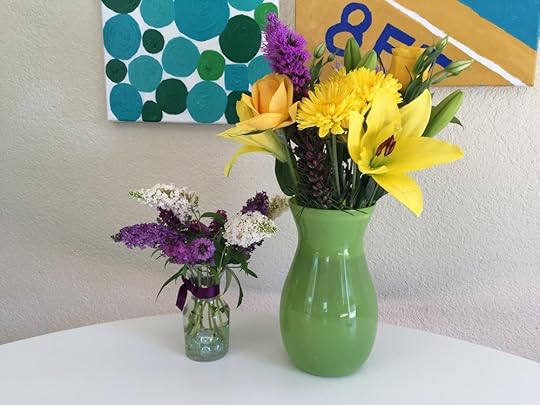
Grief does something to your memory. Having been down this road multiple times, I know this well. It's like when someone dies, grief moves into your brain and forces everything to be shifted around because there isn't as much room as before. And one of the area that loses is one's memory.
When I was working on doctorate, my dad died about the time I was finishing my coursework and getting ready to start my dissertation. There was a woman who was almost done with her dissertation and somewhere in that process he mother had died. One day in an email she told me about she couldn't find her highlighter; she had no idea where it was. And then she opened the refrigerator and there it was. Ever since then I call memory issues during grief "The highlighter in the fridge."
When my sister died, I was 21. Yes, I had responsibility but I was a college student and most of that responsibility circled around my classes. So of course it made it harder for me to keep track of assignments and content, but I don't remember having the challenge I had after my mom died just a year and a half ago. Nor do I remember it as a challenge after my dad's death nearly ten years ago.
But after my mom died– and I'm obviously older than the two previous deaths– I felt like I was constantly dropping balls. It felt as if Greg walking behind me catching them as I strolled along not realizing I was missing something. And I found he would tell me things and later I would ask him what we had discussed in our conversation. I have worked hard to at least not look like a spacey blonde but I definitely felt like the part fit me.
My life is also different than either of the previous deaths. As life isn't stagnant– and it shouldn't be– so I would expect this. Mom's death meant a different set of changes in my life though: it meant both of my parents were deceased and because I was away when my sister and my dad died, this was different because she had been living with me. Alone with a sizable house to take care of, it was challenging to keep track of everything and everyone (the four dogs included).
No matter what's happening our lives though, grief is taxing and challenging. And each time it happens we're faced with new lessons. I don't want them but they are part of moving forward and making the most of this short life we have. And leaving the highlighter in the fridge won't last forever. Grief won't take up so much space as you continue to process through it. Eventually it will only get a nook.



